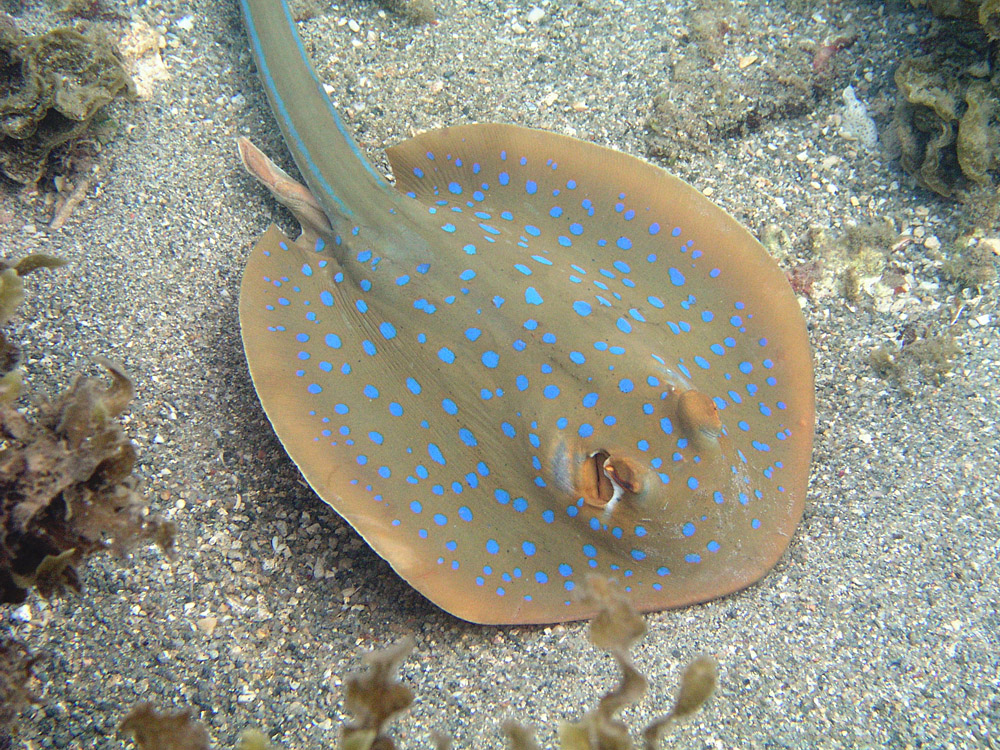Stingray Emily Jocks
Description

- Status: Threatened
- Type: Fish
- Lifestyle: Solitary
- There are 35 species.
- Stingrays are a sea floor color. This allows them to be able to camouflage themselves from predators.
- They have triangular shaped, flattened bodies that are made from pectoral fins joined to head by their tail.
- Their mouth, nostrils and gill slits are located on their underbelly. While their eyes are on the top of their head allowing them to lay in the sand and watch for prey at the same time.
- Stingrays are vertebrates and if they weren't, they would not be able to have as much strength to cause damage to their prey.
- Stingrays live about 15-25 years.
- They measure up to 6.5 ft (2m) and weigh up to 750 lbs (350 kg).
- They are outfitted with electrical sensors called Ampullae of Lorenzi. This senses the electrical charges of prey.
- Stingrays like Pufferfish, are very friendly and gentil. They are not afraid to approach tourists and are only dangerous and aggressive when threatened.
- Their main predators are larger stingrays and sharks.
An example of a Stingray size compared to a 6 ft man




Habitat:

Light yellow= Stingray waters
- Stingrays live in warm and tropical areas and are most commonly found in shallow coastal waters in temperate seas.
- When climate gets cooler the move to deeper areas.
Predator Adaptations
- Most stingrays have jaw teeth to help chew on food like; clams, mollusks, mussles, oysters, small fish, crustaceans, snails, crabs, worms and other invertebrates.
- The barb located on the tail can produce venom and be fatal to prey and humans, even when the stingray is dead. It's tail pierces through it's prey and stops them from escaping. Their tail is serrated or barbed and extemely thin, this lets the stingray whip it's tail almost in almost any direction because of it's flexibilty and agility.
- The eyes on top of their head allows them to lay in the sand, while watching for nearby prey. When eating they will lay in the sand, only tail and eyes showing, but since their eyes are on top of their head and their mouth on their underbelly, they use smell and electro-receptors to hunt for prey.
- Coral reefs are an example of their hunting grounds. They share this area during high tide, with the Sea Turtle and different types of shark including, the Reef Shark.
Prey Adaptations
- It's main threats are sharks like the warm water Tiger Shark, seals, hammer head sharks, sea lions, large carnivorous fish and humans.
- The stingray only has a few predators due to it's size and shape. The stingrays shape helps them by letting them lay flat on the sea floor without being noticed.
- The hammer head shark is a main predator of the stingray because the shark has electro-sensors that detect the stingrays laying in the sand and because they have become immune to the stinrays venomous stinger.
Symbiotic Interactions
- Stingrays have a mutualistic relationship with Bluehead Wrasses and Spanish Hogfish. These species make a "cleaning station" with stingrays.
- Stingrays and fish also have a relationship with eachother when fish hover above stingrays that search for food in the sand. When the stingray uncovers prey from the sand, the fish hovering above them eats the fish the stingray does not.
- The stingrays get parasites and mucus cleaned off of them, while the fish that clean them get a meal.
Species Comparison of the Spotted Eagle Ray Stingray and the Blue Spotted Stingray

2.jpg)

Spotted Eagle Ray Blue Spotted Stingray
Similarities:
- The Eagle ray and the Blue spotted stingray both have venomous barbs located on their tail.
- They both have their mouth and gills on their under belly, while their eyes are on top.
- They both have spots.
- The two types of stingrays both eat shrimps, mollusks, worms etc.
- For both stingrays their predators are sharks like the hammerhead.
Differences:
- The spotted eagle ray is sometimes located in southern Australia. The blue spotted stingray is sometimes located in northern Australia.
- The spotted eagle ray measures about 8.2 ft (2.5 m) in length, not including the tail.
- The Blue spotted ray measures about 70 cm.
- The Spotted eagle ray has a snout like nose to help dig in mud to search and hunt for food.
- The Blue spotted ray searches buries itself low in the sand, and by coral reefs to search for food. It is able to dig in the sand because it does not have a snout like nose.
Resources:
National Geographic, 2010, National Geographic/stingray February 12,2010 http://animals.nationalgeographic.com/animals/fish/stingray.html
Animal Discovery, September 10, 2008, Discovery Communications, February 18, 2010 http://animal.discovery.com/fish/stingray/pictures/stingray-picture.jpg
DF Walker school, Stingray, 2010, DF Walker school, February 23, 2010 http://library.thinkquest.org/J002967/page4.html
Picture http://johnnykaje.files.wordpress.com/2010/01/stingray-3.jpg
http://www.barrierreefaustralia.com/text-only/sting-rays_text_only.htm
http://a-z-animals.com/animals/stingray/
http://bioweb.uwlax.edu/bio203/s2009/long_nico/Interactions.htm
Fabien Cousteau, Ocean The world's last wilderness revealed, American Musuem of Natural History, 2006
Picture+ info http://bioweb.uwlax.edu/bio203/s2007/korsch_alys/
Comments (6)
Oonagh McDowell said
at 5:21 pm on Feb 17, 2010
i made a link on yours tooo!!!!!!!!!! hahaha
-oonagh
Amanda D said
at 1:03 pm on Feb 23, 2010
this is good.
Hugh H said
at 6:48 pm on Feb 23, 2010
nice job!
Emily J said
at 12:34 pm on Feb 24, 2010
thx
Andrew Cohen said
at 3:50 pm on Feb 25, 2010
HI!!!
Andrew Cohen said
at 3:50 pm on Feb 25, 2010
sorry i felt left out...
You don't have permission to comment on this page.